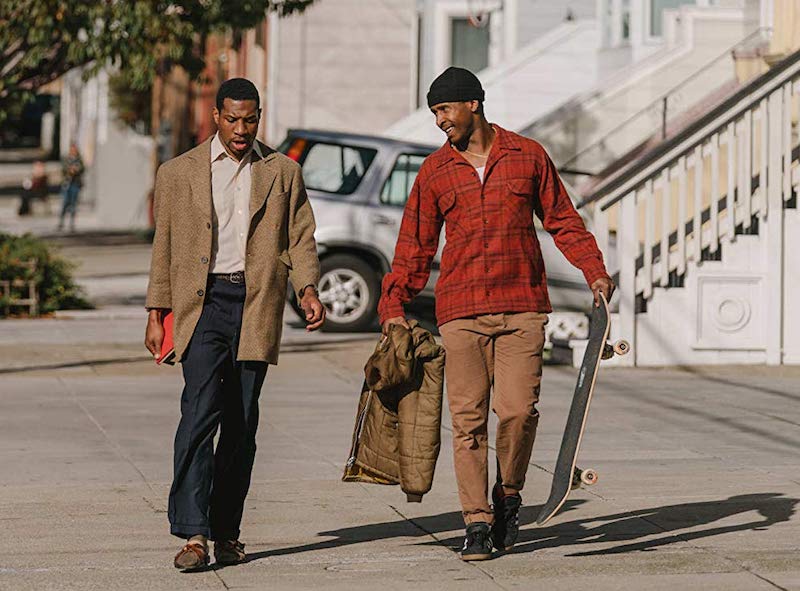Searching for San Francisco’s Lost Heart
Sundance Film Festival award-winner "The Last Black Man in San Francisco" zooms in on a once-vibrant culture dimmed by gentrification. Jimmie Fails, right, and Jonathan Majors take a stroll in "The Last Black Man in San Francisco." (IMDb)
Jimmie Fails, right, and Jonathan Majors take a stroll in "The Last Black Man in San Francisco." (IMDb)
It comes as little surprise that “The Last Black Man in San Francisco” took special jury and directing awards at January’s Sundance Film Festival. The new movie, opening Friday in New York, Los Angeles and San Francisco, is a love letter to the city by the bay by lifelong resident Joe Talbot, and a stunning debut by the first-time director. Based on first-time actor Jimmie Fails’ true story, this nuanced and poetic look at gentrification is told through the eyes of two people who dwell on the margins of the city where they grew up.
Guys in hazmat suits neutralize an unidentified toxin as a soapbox preacher admonishes no one in particular near San Francisco Bay at Hunters Point, the southern tip of the city, which sits on the horizon like a storybook palace. “Fight for your home,” the preacher bellows. “Our sweat sinks in the wood. This is our home!”
Two men watch from across the street. One wears a somber expression and carries a scarred skateboard. The other is nattily dressed for the urban hinterlands. They are Jimmie Fails, starring as himself, and Jonathan Majors, in a dynamic performance as Fails’ quirky friend, Montgomery “Mont” Allen. Here, in the middle of nowhere, their comments make us wonder if they’re a willing audience.
It turns out they aren’t. They are waiting for a bus that doesn’t come. So they hop aboard Fails’ skateboard and take a delirious ride across town, giving Talbot, who so eloquently set the tone in the desolate opening frames, a chance to cut loose with an evocative montage of the city. Its refurbished Victorian veil melds with modern landmarks, the faces of the homeless (in escalating numbers), commuters, scowling white faces (some of them cops)—a fixture in the landscape of the two black men. The good and bad of the streets are made lyrical over Emile Mosseri’s rhapsodic score.
Their destination is a picture-perfect Fillmore District Victorian house, with gingerbread trimming, fish-scale shingling and a witch-hatted turret. Fails sets to work touching up the already well-kept property, his childhood home and one his grandfather, known as “the first black man in San Francisco,” built with his own hands. The problem is, the house isn’t his; it belongs to an elderly white couple, who threaten to call the police if he doesn’t stop trespassing.
The two friends crash in the cramped home Mont shares with his grandpa, a half-garage decorated with Playbill covers, suggesting a passion for theater. Homelessness happens by degrees; when people like Fails lose their place for whatever reason, they often land on a friend’s sofa or in a car, and finally, when they’ve tested the limits of generosity, they wind up on the street.
It’s appropriate that Danny Glover—a longtime resident and symbol of San Francisco—playing Mont’s blind Grandpa Allen, is entertained by the noir classic “D.O.A.,” a film set in the same city. Talbot might have chosen any number of San Francisco-based movies—“Dirty Harry,” “Vertigo,” “The Maltese Falcon”—but only “D.O.A.” shares the fatalism reflected in the thematic layers of his own film.
Just as Edmond O’Brien’s search for his own murderer in order to find an antidote before the poison he’s ingested takes effect in the 1949 movie, Fails’ plan to retake his family home is doomed to failure, even when it’s suddenly left vacant. “You don’t own shit!” concludes Bobby, played in two morosely amusing scenes by Mike Epps, as they observe a site where 100 residents have recently been evicted from what had been a rent-controlled building.
It’s a conclusion Fails ought to have arrived at some time ago. The family home sits smack in the center of what was once the “Harlem of the West,” a vibrant, post-World War II jazz nexus. Before the war, African Americans made up less than 2% of the city’s population. After the war, that number jumped to 5%, later peaking at 13.5% in 1970. Today, it has dropped back to roughly 5%.
Fails’ relationship to his roots is a shaky one as he visits his estranged father, a bootlegger of commercial movie DVDs. Best known as Officer Powell on “Stranger Things,” Rob Morgan grounds his performance in a withering sense of bitterness with a touch of belligerence, deftly suggesting a past that has kept father and son apart.
A chance encounter with Fails’ mother, a plot point taken from real life, takes place on a bus. Speaking on the phone and fussing with work details, she suddenly makes eye contact and freezes. The scene brims with emotion and regret, as well as a sense of finality, over having moved on from having ever been related. They trade lines like a high school teacher and former student, then part without exchanging promises to keep in touch.
The history of most cities is layered with episodes of one group of people pushing out another. But the African American families in the Fillmore District didn’t push out the Japanese American families. That ignoble task was performed by the U.S. government which, doubting Japanese Americans’ allegiance, interned a portion of its citizenry in camps during the war.
A chorus of gangsters loiters in front of the building where Grandpa Allen resides, constantly haranguing Fails and Mont, though their bark seems worse than their bite. One of them is played by Jamal Trulove, whose own real-life saga began when he spent six years in prison after he was framed for murder by the San Francisco Police Department. Acquitted in 2015, he won a $13.1 million settlement mere days before production on the film began. In the movie, his death becomes a catalyst for Mont, who writes a play that lays down certain visceral truths about marginalization and survival. It also lays bare to Fails the true origins of the house.
City neighborhoods take on a variety of colors over the decades, but gentrification always ends in white. In the final scenes, two such hipsters are overheard on a bus, complaining about how boring San Francisco has become and considering a move to East L.A. There, a long-entrenched Latinx community in Boyle Heights (that supplanted a long-entrenched Jewish community before it) is fighting gentrification. And when that battle is lost, white people will move on to the next cultural touchstone and bleach it of its vitality.
Talbot and co-writer Rob Richert address issues of race and class with subtlety, eschewing bold proclamations and thereby achieving greater resonance. At the movie’s heart is a yearning for a bygone time and place, or perhaps one that never was. The beat of that heart is governed by the friendship between Fails and Mont.
In his debut, Fails exhibits a natural, if stoic, demeanor that serves him well when third-act cracks begin to materialize. He convincingly embodies an immovable object opposite Majors’ Mont, an irresistible force who moves through life consuming and digesting the experiences of others, processing through his sullen days as a fishmonger, then calling them up again in the form of drawings and finally a play.
A graduate of Yale School of Drama, Majors is known for “White Boy Rick,” with Matthew McConaughey, as well as Jordan Peele’s anticipated HBO series, “Lovecraft Country.” His work here appears so minimal as to seem nonexistent at first. But what eventually emerges is a vibrant inner life, an empathetic soul with a playful intellect, and, most of all, a loyal friend.
Talbot works from the heart, conjuring a warm and relevant film that examines a callous world of spreading homelessness during a time of unprecedented wealth, and once-vibrant urban culture centers now in decline or perished. A soulful paean to unfortunate times of great fortune in a great city, “The Last Black Man in San Francisco” is a story from the sidelines, told with truth and beauty.
Your support matters…Independent journalism is under threat and overshadowed by heavily funded mainstream media.
You can help level the playing field. Become a member.
Your tax-deductible contribution keeps us digging beneath the headlines to give you thought-provoking, investigative reporting and analysis that unearths what's really happening- without compromise.
Give today to support our courageous, independent journalists.






You need to be a supporter to comment.
There are currently no responses to this article.
Be the first to respond.